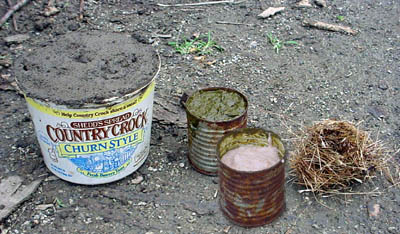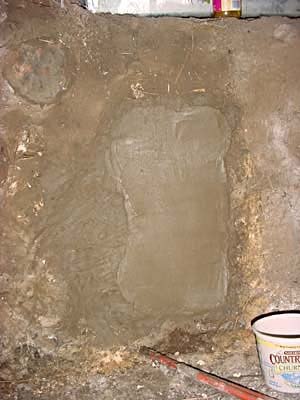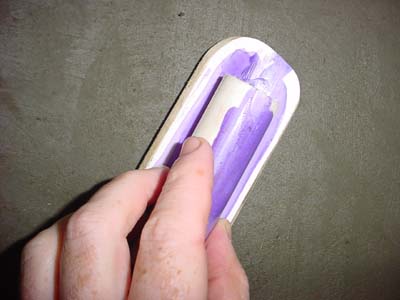Earth Plaster: Difference between revisions
No edit summary |
|||
| Line 49: | Line 49: | ||
800 ml sifted soil, hydrated to a gel/paste like consistency. | 800 ml sifted soil, hydrated to a gel/paste like consistency. | ||
Gathered soil from edge of the duckpond. Since the soild was naturally hydrated, it was easy to sift using the 1/8" screen. | Gathered soil from edge of the duckpond. Since the soild was naturally hydrated, it was easy to sift using the 1/8" screen. | ||
[[Image: PondMud.jpg]] | |||
800 ml sifted sand. Used the same 1/8" screen for sifting. | 800 ml sifted sand. Used the same 1/8" screen for sifting. | ||
Revision as of 23:14, 15 August 2008
Finish Earth Plaster to cover interior of cordwood / earthbag structure
Attempt 1
-Travis Toon
Ingredients
1500 ml sifted soil, hydrated to a gel/paste like consistency. Gathered subsoil (16 inches deep) from near the well. Hydrated the soil and sifted it using 1/8" screen.
200 ml fresh cow manure. So fresh there was still steam rising off the top. I am told freshness is not necessary, but that composted manure is worthless.
180 ml wheat paste. Added whole wheat flour and cold water in a pan. Stirred together well. Then heated until pasty. Add immediately. I ate the leftovers which were quite tasty.
Handful of micro straw. This particular grass was found above the tent site 10-15 ft short of the property line near the goat fence. Chopped into 1" lenghths. Did not include roots or seed stalks.
Procedure
Mixed together above ingredients by hand until homogenous.
Chose an area that was relatively smooth and void of large holes. Areas with holes much larger than 2" wide by 1" deep should probably be prepared with a rough plaster mix, i.e. cob.
Pre-soaked the area to be plastered. Waited 20 minutes for water to penetrate old cob.
Made a slurry. Took 10% of the plaster and mixed it with water in a separate bowl so that it would go on very thin.
Re-wet the area immediately before applying slurry.
Applied (smeared) slurry with hand approximately 1/16" thick.
Applied plaster about 1/2" thick by hand over the slurry. The plaster was very easy to work with.
Troweled the area. The tool for this was improvised from a piece of 6" diameter PVC pipe fitted with a 1" PVC handle.
12 hours later smoothed out the trowel lines. The tool for this was a lid from a medium sized yogurt container. Used a pair of scissors to cut off the outer edge of the lid.
Attempt 2
Ingredients
800 ml sifted soil, hydrated to a gel/paste like consistency. Gathered soil from edge of the duckpond. Since the soild was naturally hydrated, it was easy to sift using the 1/8" screen.
800 ml sifted sand. Used the same 1/8" screen for sifting.
200 ml fresh cow manure.
180 ml wheat paste. Added whole wheat flour and cold water in a pan. Stirred together well. Then heated until pasty. Add immediately.
Two handfuls of micro straw. This particular grass was found above the tent site 10-15 ft short of the property line near the goat fence. Chopped into 1" lenghths. Did not include roots, but got lazy and let some seed stalks in.
Procedure
Mixed together above ingredients by hand until homogenous.
Chose an area that was relatively smooth and void of large holes. Areas with holes much larger than 2" wide by 1" deep should probably be prepared with a rough plaster mix, i.e. cob.
Pre-soaked the area to be plastered. Waited 20 minutes for water to penetrate old cob.
Made a slurry. Took 10% of the plaster and mixed it with water in a separate bowl so that it would go on very thin.
Re-wet the area immediately before applying slurry.
Applied (smeared) slurry with hand approximately 1/16" thick.
Applied plaster about 1/2" thick by hand over the slurry. The plaster was very easy to work with.
Troweled the area. The tool for this was improvised from a piece of 6" diameter PVC pipe fitted with a 1" PVC handle.




